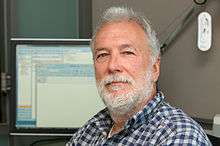James R. Goodman

James Richard "Jim" Goodman (born July 16, 1944) is a professor of computer science at the University of Auckland in Auckland, New Zealand, and emeritus professor at the University of Wisconsin–Madison.
Education and research
Goodman received a PhD from the University of California, Berkeley in 1980. He joined the faculty at the University of Wisconsin–Madison the same year as an assistant professor of computer science.
Goodman's research is focused mainly on computer architecture: the hardware/software interface. His current interests are primarily focused on support for Transactional Memory. Goodman's seminal 1983 paper, "Using cache memory to reduce processor-memory traffic", was the first to describe snooping cache coherence protocols and to identify the phenomenon of cache being able to conserve the memory bandwidth.[1]
Goodman is the co-author of "A Programmer's View of Computer Architecture", a highly acclaimed book on computer architecture,[2] and co-authored with Andrew Tanenbaum a book on Computer Organization.[3] In 2007, he was named a Fellow of the IEEE "for contributions to shared-memory multiprocessor system design".[4] In 2010, he was named a Fellow of the Association for Computing Machinery "for contributions to parallel processor and memory system design."[5] In 2013, he received the Eckert–Mauchly Award for "breakthroughs in architecture of shared-memory multiprocessors". [6]
Personal
Goodman was born in 1944 in Topeka, Kansas. Because of his expertise in the field of computer science, he has been interviewed several times as an expert on TV shows such as Campbell Live.[7]
References
- ↑ J.R. Goodman (1983). "Using cache memory to reduce processor-memory traffic". ISCA '83: Proceedings of the 10th annual international symposium on Computer architecture, Stockholm, Sweden: 124–131. doi:10.1145/800046.801647. ISBN 0-89791-101-6.
- ↑ J.R. Goodman, K. Miller (1993). A Programmer's View of Computer Architecture: With Assembly Language Examples from the MIPS RISC Architecture.
- ↑ A. Tanenbaum, J.R. Goodman (1998). Structured Computer Organization, 4th edition.
- ↑ http://www.ieee.org/membership_services/membership/fellows/alphabetical/gfellows.html
- ↑ http://www.acm.org/press-room/news-releases/2010/fellows-2010
- ↑ http://awards.acm.org/press_releases/em-award-13a.pdf
- ↑ "The Trouble with Broadband". Campbell Live. 2007-01-30.
External links
- James Goodman's page at Auckland
- James Goodman's page at Wisconsin
- James Richard Goodman's page at the Mathematics Genealogy Project
- James Goodman's profile on the ACM website
- James Goodman's profile on the IEEE Computer website